
FEBRUARY- MAY 2024



FEBRUARY- MAY 2024



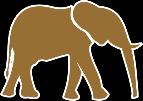
During February to May 2024 the SWT/KWS Sky Vet program was called to handle 15 wildlife cases all of which involved elephants, including 9 injuries directly related to poaching and 2 to Human – Wildlife Conflict.
Three elephants suffered snare wounds, two with spear injuries and four with arrow injuries. One elephant calf with a snare injury to her foot sadly died during treatment due to complications associated with the long-standing snare but the other 8 were treated successfully with a good prognosis for full recovery.
One of the Human – Wildlife Conflict cases involved a young elephant bull that was stuck in a deep well full of water. It took a heroic effort, and the collaboration of the Sky Vet Unit, SWT Staff, Aerial Unit, as well as sourcing a crane to extract the bull to safety. The other HWC Case involved the translocation of one adult female elephant and her two calves from the Mtito Area after reports from the community. With the aid of a helicopter, truck, tractor and crane, all three were relocated to Tsavo East National Park. The other cases were all likely caused naturally, 3 where treated successfully and one was given a guarded prognosis.
Out of the cases treated there was an overall 87% success rate.
The Sky Vet program has deployed KWS vets to the following locations during this reporting period
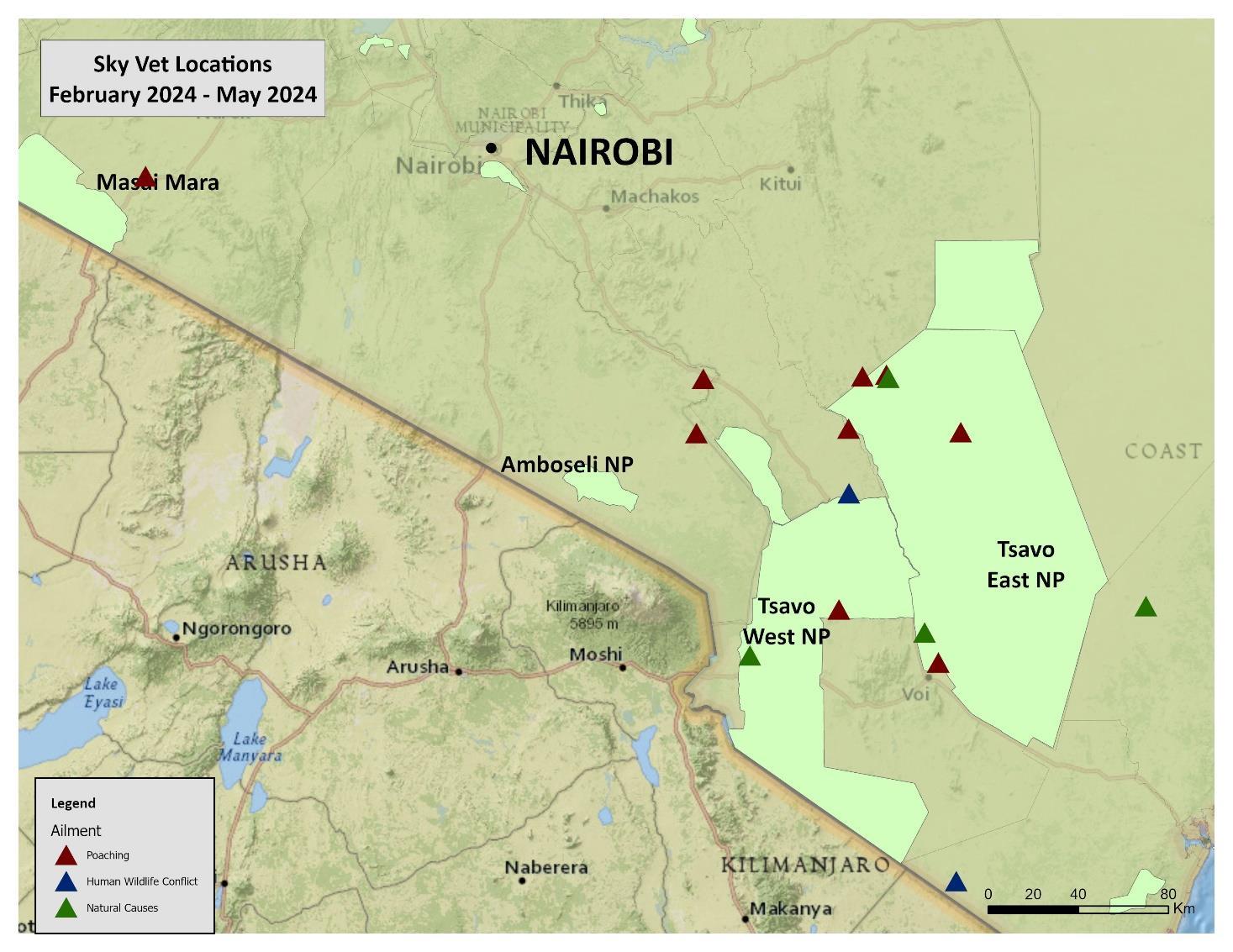
15 Elephant Cases Attended to by the SWT/KWS Sky Vet Unit
February - May 2024
Outcomes of Cases Attended to by the SWT/KWS Sky Vet Unit
February - May 2024

The elephant bull was spotted by the Sheldrick wildlife trust plane while on routine patrols around the conservation area. It was noted that he had a swelling on his face and was also reluctant to move. The Tsavo vet unit was notified and were airlifted to the area.
Immobilisation, examination and treatment
The team decided to immobilize the elephant for closer examination and possible treatment.
The bull was immobilized using 20mg of Etorphine hydrochloride in a 3cc dan-inject dart. He was darted from the helicopter and was deep under anaesthesia 8 minutes later.
Examination revealed that the swelling was fibrous tissue that had formed as part of wound healing process. No other injuries were observed. The bull received antibiotics, anti-inflammatories, and metabolic stimulants parenterally.
The bull was revived using 250mg Naltrexone hydrochloride given intravenously via a prominent ear vein. He rose and walked away 3 minutes later with a good prognosis.
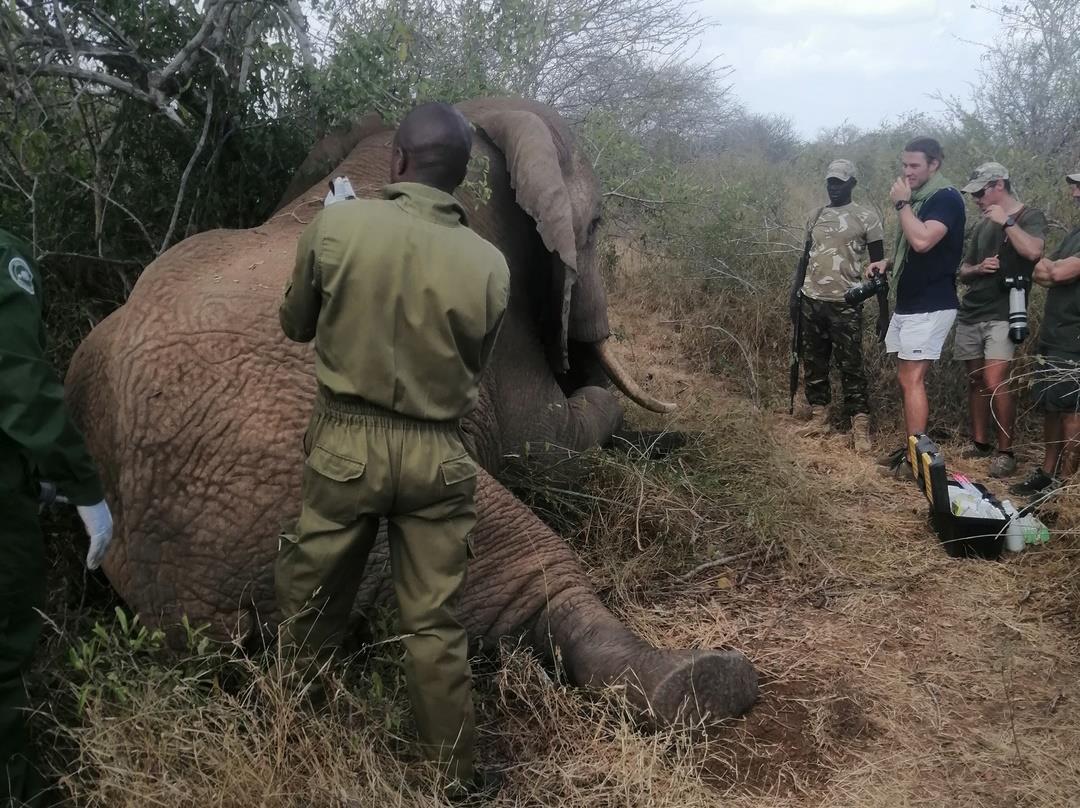
The elephant bull was spotted by the Sheldrick wildlife trust pilot during routine air patrol with a wound on his left rump. The Tsavo Vet Unit was notified and airlifted to the area to examine and treat this elephant.
The bull was immobilized using 20mg of Etorphine hydrochloride delivered remotely in a 3cc dan-inject dart. Darting was done from the helicopter. He was fully anesthetized 9 minutes later.
Examination revealed a deep pus-filled wound (suspected to be a spear wound) at the left rump area. The wound was thoroughly cleaned of pus and devitalized tissues removed. It was thereafter flushed with Hydrogen peroxide, rinsed with clean water and infused with tincture of Iodine. The deep wound was then packed with antibiotic pessaries and applied with topical antibiotic spray.
He was given anti-inflamatories (flunixin meglumine), antibiotics (amoxicillin) both parenterally.
He was revived using 200 mg of Naltrexone hydrochloride given intravenously through an ear vein, he was up and going 3 minutes later with a good prognosis.
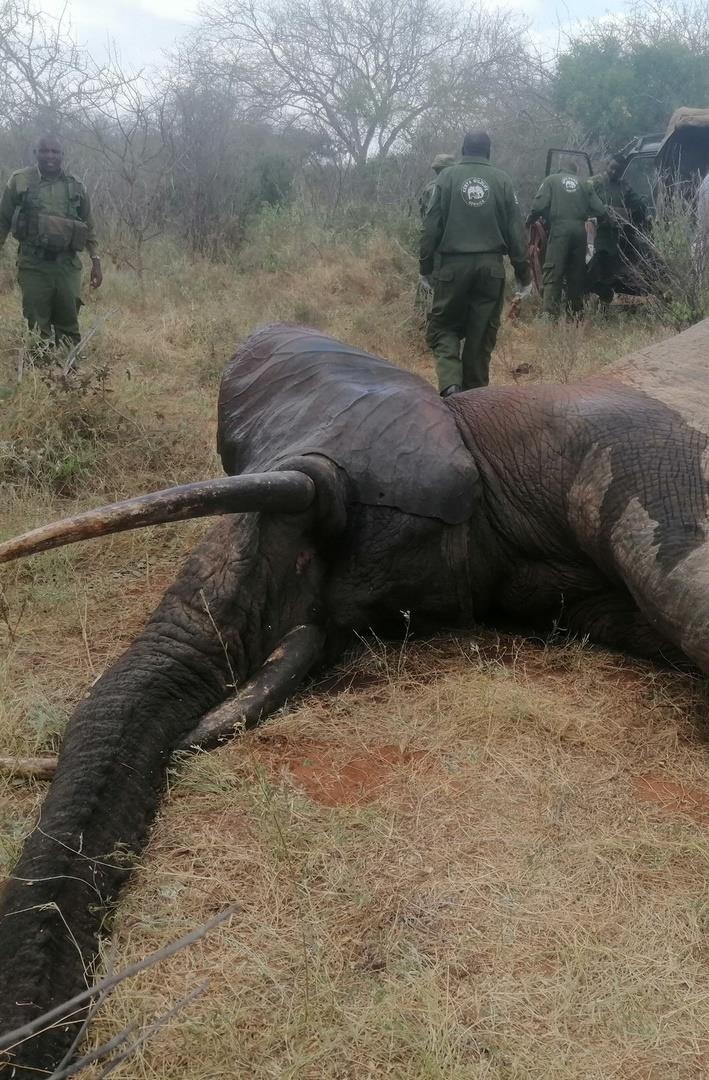

An injured elephant bull was spotted in Kishushe area by SWT pilot on patrol in collaboration with KWS/SWT rangers who were at this location. He had a wound on his right flank area.
Immobilisation, examination and treatment
He was immobilized using 20mg of Etorphine remotely delivered in a 3cc dan-inject dart from the helicopter. It took 9 minutes for the drug to achieve its full effects.
Examination revealed a deep spear wound on his right flank; the wound was oozing pus. He also had 2 other wounds on the ventral area on the base of his trunk. All three wounds were thoroughly cleaned with clean water. Pus and devitalized tissues were removed, this was followed by flushing the wound with Hydrogen peroxide. The wound was then washed with clean water dried using swabs and infused with tincture of iodine solution. Topical antibiotic spray was applied on all the wounds. The deep spear wound in the flank was packed with antibiotic pessaries. He was then given antibiotics and anti-inflamatories parenterally
Prognosis
He was revived using 200mg of Naltrexone hydrochloride given intravenously through an ear vein. He was up and going 3 minutes later with a good prognosis.
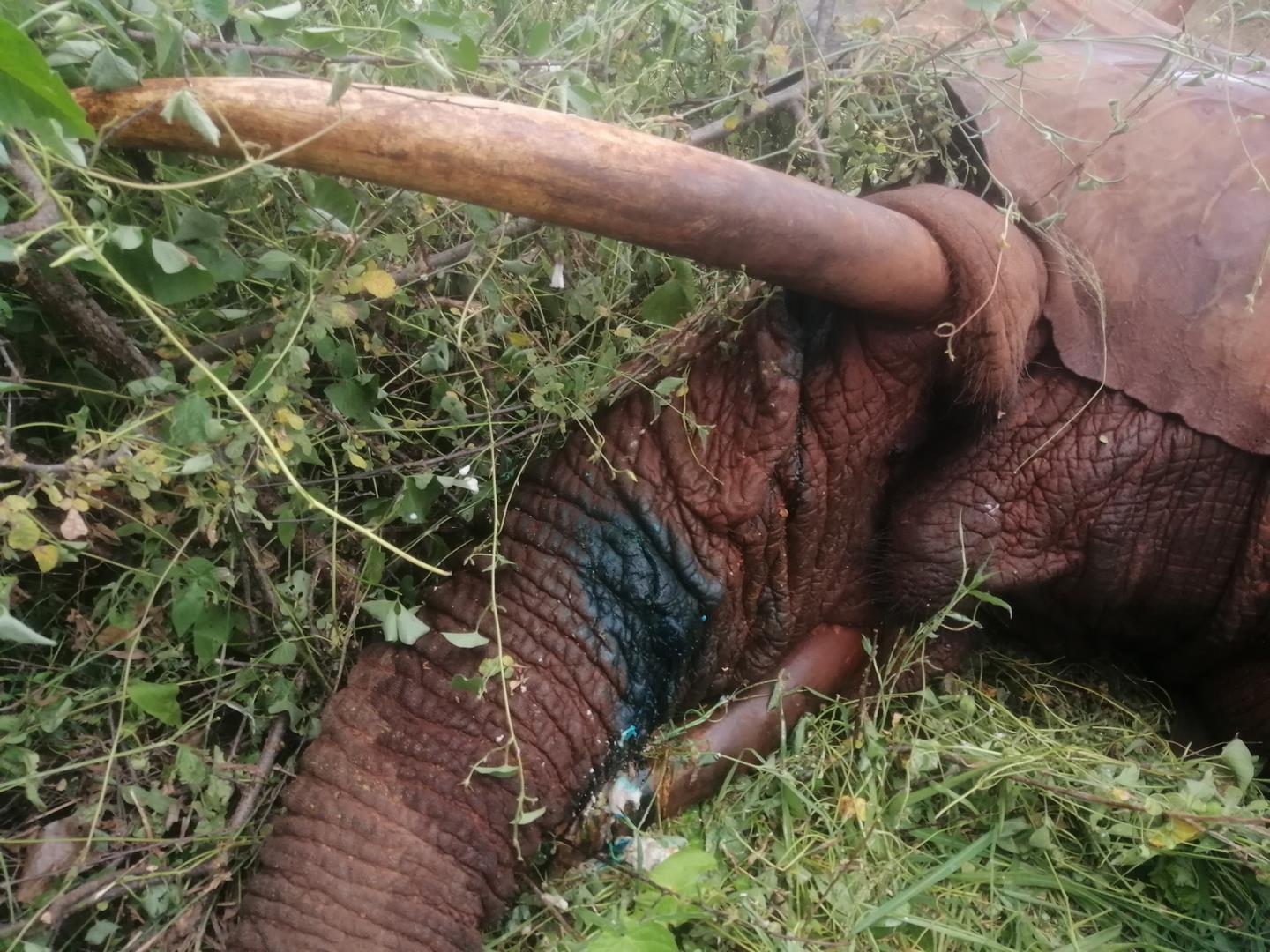
The elephant bull was spotted Sheldrick air patrol pilot. He had a swelling on his rump area.
Immobilisation, examination and treatment
He was anaesthetized using 20 mg of etorphine hydrochloride delivered on a 3cc daninject dart. Darting was done from the helicopter. It took 8 minutes for the drug to achieve its full effect.
Examination revealed a firm swelling on right side of the rump with pus oozing from a small opening on the swelling. The opening was extended to evacuate the contents of the abscess. The abscess was then flushed using hydrogen peroxide, washed with clean water, dried with swabs and infused with tincture iodine solution.
Antibiotic pessaries were packed into the wound and topical antibiotic spray applied. He was also given antibiotics (amoxicillin) and anti-inflammatories (flunixin meglumine) parenterally.
Prognosis
He was reversed from the anaesthesia using 200mg of Naltrexone hydrochloride. He woke up three minutes after reversal to join the rest of the bull herd a few meters away.
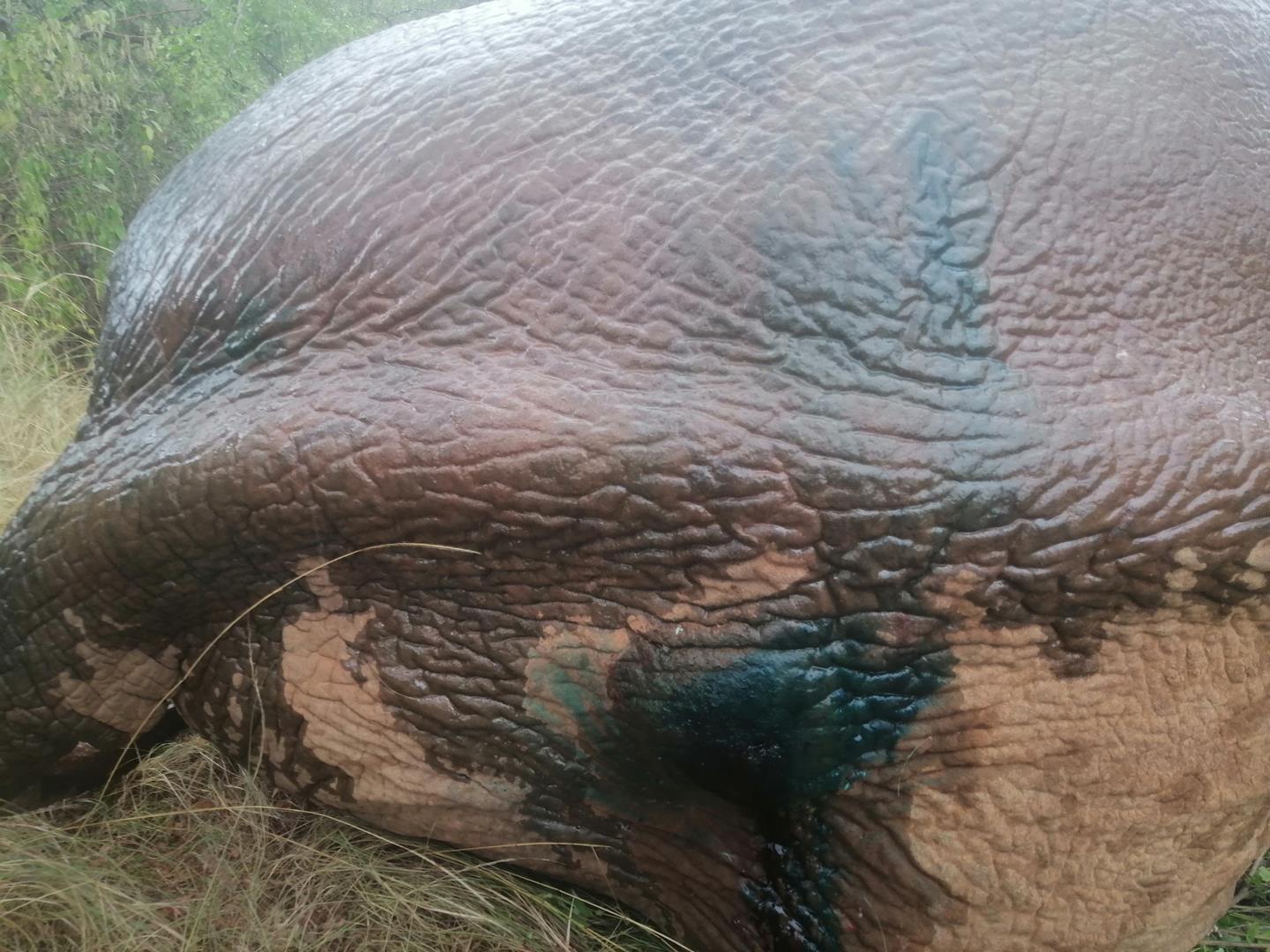
Elephant Snared Elerai, Kiboko
KWS PAMU based at Kiboko reported the sighting of a lame adult elephant bull.
Immobilisation, examination and treatment
The elephant was found alone possibly since it was unable to keep up with its herd due to pain and lameness. The injured animal was darted from a helicopter and immobilized with 20 mg Etorphine HCl. The helicopter then assisted in preventing the elephant from moving into the bush. Full immobilization was attained 10 minutes post-darting.
A severe wound inflicted by a deeply embedded snare on the left front limb was observed. The wound oozed pus and blood due to the deep injury. The snare was cut loose with wire cutters then the pus-filled wound was drained and irrigated with Hydrogen peroxide and Iodine solution. An Amoxicillin injection was administered intramuscularly, and Oxytetracycline spray applied topically to cover for bacterial infection. The bull was revived with Naltrexone and woke up after drug administration.
Prognosis
The elephant bull has a good prognosis.



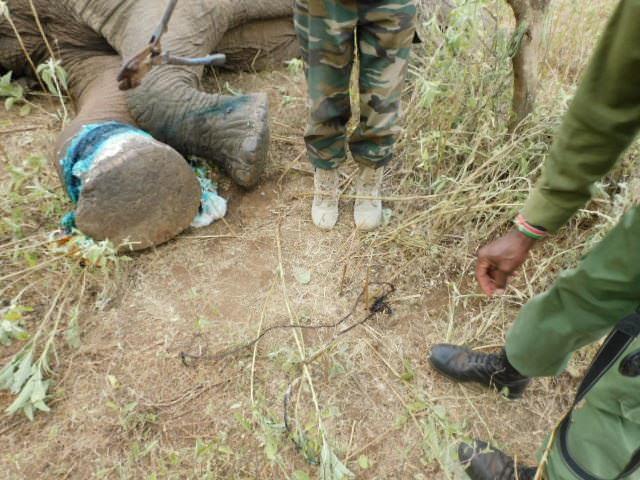
The bull was spotted limping by the KWS and SWT de-snaring team during routine patrols. TMVU was notified and responded timely.

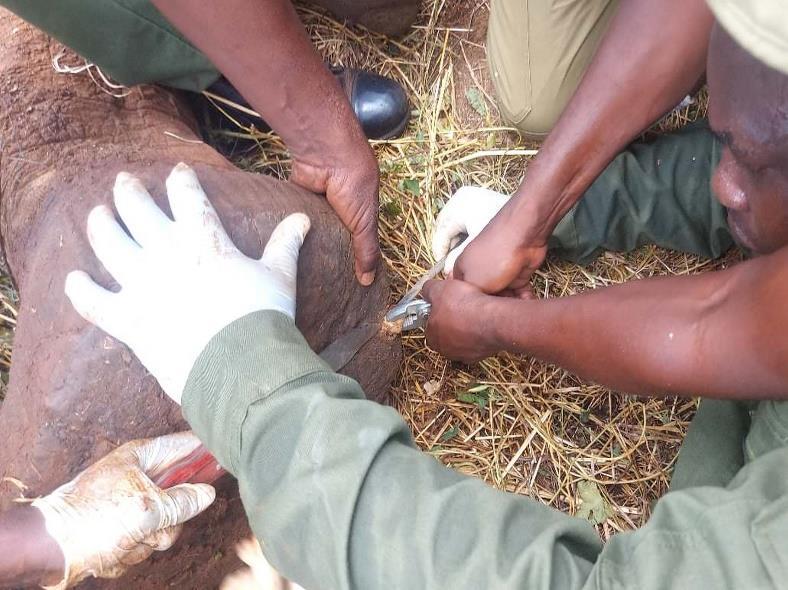
The bull was immobilized using 20mg of Etorphine hydrochloride in a 3cc daninject dart. He was darted from the helicopter and was deep under anaesthesia 8 minutes later.
Examination revealed a 12cm long wooden splinter lodged deep into the foot pad of his left forelimb, the splinter was gently pulled out and was successfully dislodged. The wound left was still fresh and free of pus it was therefore flushed with Hydrogen peroxide, rinsed with water and infused with tincture of Iodine. Antibiotic pessaries were there after packed deep into the wound followed by a topical antibiotic spray. The bull received antibiotics and anti-inflammatories parenterally.
The bull was revived using 250mg Naltrexone hydrochloride given intravenously via a prominent ear vein. He rose and walked away 3 minutes later. Prognosis is good.


The bull was spotted limping with a swollen right forelimb by the KWS and SWT rangers during routine patrols. TMVU was notified and airlifted to attend to the elephant.
Immobilisation, examination and treatment
The bull was successfully anaesthetized with 17mg of Etorphine hydrochloride delivered in a 3cc dan-inject dart. Darting was done from foot and full anaesthesia was achieved after seven minutes.
Examination revealed extensive firm swelling and a septic wound at the carpus of his right forelimb, on aspiration the swelling was confirmed to be an abscess. The wound was also confirmed to be deep and close to the joint capsule. The abscess was incised and drained of its contents. All devitalized tissues within the wound were removed with clean water and infused with Hydrogen peroxide to break down the pyogenic membrane. Tincture of Iodine was infused into the wound followed by packing of antibiotic pessaries. A topical antibiotic spray was applied on the point of incision.
He was also given antibiotics and anti-inflammatory drugs parenterally
Revival and prognosis
The bull was revived using 170mg Naltrexone hydrochloride given intravenously via a prominent ear vein. He rose and walked away 3 minutes later. Prognosis is guarded. .


This bull was spotted by the KWS and SWT de-snaring team during patrols around the Ithumba area. He was limping and had a swelling on his left shoulder area .TMVU was notified and responded immediately.
Immobilisation, examination and treatment
The bull was immobilized using 18mg of Etorphine in a 3cc dan-inject dart delivered remotely. Darting was done from the helicopter and it took 9 minutes for the drug to take full effect.
Examination revealed a firm swelling on the left shoulder which had a small opening that was oozing pus and that there was extensive skin thickening at the area. It was suspected to be an arrow wound. An incision was made on the ventral aspect of the swelling to drain its contents and through and through lavage was carried out, the wound was then flushed with Hydrogen peroxide, washed with water and infused with tincture of Iodine. The wound was thereafter packed with antibiotic pessaries and applied with topical antibiotic spray. The bull was given antibiotics and anti-inflammatories before reversal.
Revival and prognosis
The bull was revived using 200mg Naltrexone hydrochloride given intravenously via a prominent ear vein. He rose and walked away 3 minutes later. Prognosis is good.

Sheldrick Wildlife Trust (SWT) management informed the Amboseli Mobile Veterinary Unit of a snared elephant bull in Tsavo East National Park. The Veterinary team was airlifted from Amboseli to the treatment site by SWT aircraft.
Immobilisation, examination and treatment
The snared elephant was found in a family of 3 elephants. A fabric strap snare could be seen around its neck and trunk. The snared elephant was separated from the family group to facilitate treatment. It was successfully darted from a helicopter and immobilized with 18 mg Etorphine HCl. The helicopter assisted in keeping the elephant from venturing into the bush before the drugs took effect 10 minutes later. Upon examination, a severe wound inflicted by the embedded fabric snare was observed on the elephant’s trunk. The deep wounds were oozing pus and blood. The wounds were cleaned and irrigated with Hydrogen peroxide and Iodine solution. Amoxicillin was administered intramuscularly and Oxytetracycline spray applied on the wound to cover for bacterial infection. The bull was successfully revived with Naltrexone posttreatment.
Prognosis
The elephant bull has a good prognosis.




KWS rangers patrolling Kuranze ranch spotted a young elephant bull trapped in deep pit full of water. The SWT/KWS Tsavo Veterinary Unit teamed up with SWT and KWS field officers for the rescue.
An advance team comprising members of the veterinary unit and SWT staff flew to the area to assess the situation and pump out as much water from the well as possible to prevent the elephant from drowning. Other members of the veterinary unit and SWT teams followed by road with more pumps and other equipment. A heavy-duty crane was availed to lift the bull out of the deep pit. Another crane was also on standby to lower 2 personnel into the well to secure hoisting straps on the elephant’s limbs.
The bull was immobilized using 13 mg Etorphine hydrochloride, it took 4 minutes for the drug to take effect. Once the straps were secured on the elephant’s limbs, the animal was carefully hoisted out of the pit and placed a safe distance from the well. The bull’s vitals were checked, and steroidal anti-inflammatories, metabolic stimulants, and Amoxicillin antibiotics were administered parenterally. Anaesthesia was reversed with 200mg Naltrexone hydrochloride given intravenously via a prominent ear vein. The bull stood and walked away 4 minutes later.
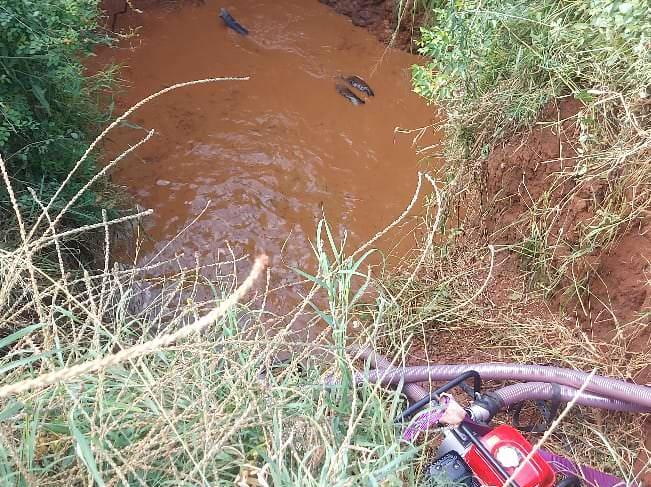
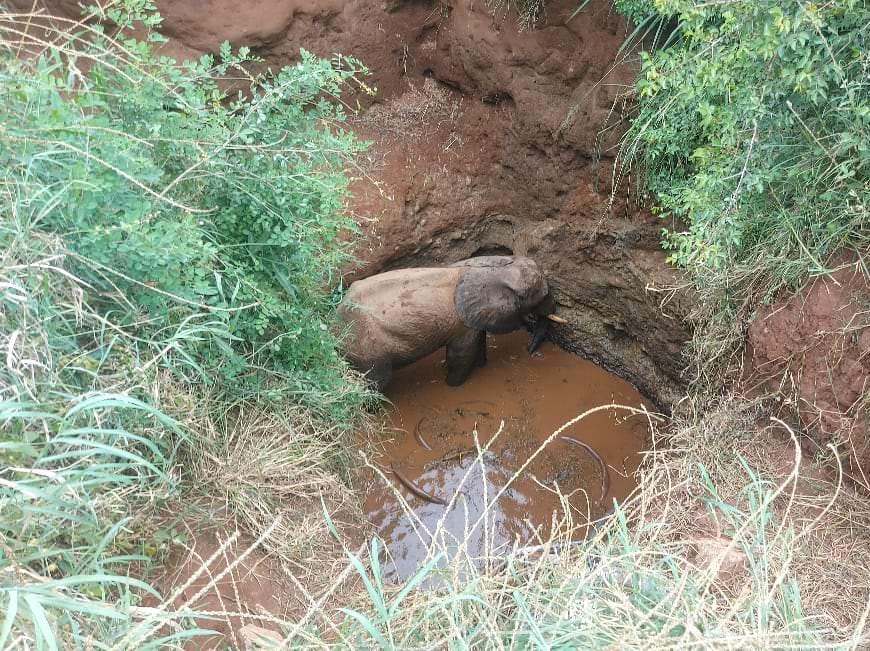
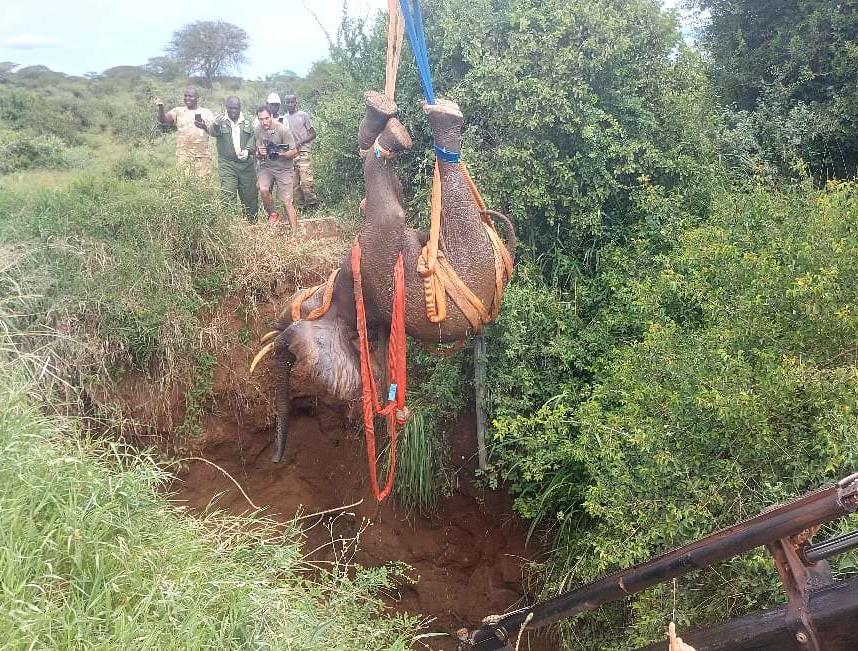

Residents of Mtito Andei area reported that 3 elephants (a mother and her 2 calves – male & female) had strayed from the park and were roaming in the community which was raising alarm. KWS management requested the SWT/KWS Tsavo Veterinary Unit to translocate them to Tsavo East National Park.
The cow and the 2 calves were darted from a helicopter and immobilized with 17 mg, 8mg, and 3mg Etorphine respectively. It took 8 minutes, 9 minutes, and 7 minutes for the drug to achieve its full effect on the mother and her calves respectively.
The elephants were doused liberally with water to help cool them off. They were then loaded onto the translocation truck and tractor by a crane and transported to the release site in Tsavo East National Park. Anaesthesia monitoring was done during transit to ensure sufficient depth.
At the release site, the cow and the 2 young bulls were simultaneously reversed using 200mg, 150mg and 100mg Naltrexone hydrochloride given intravenously via a prominent ear vein after 45 minutes in transit. 3 minutes later they all stood and walked away together into the nearby thicket.

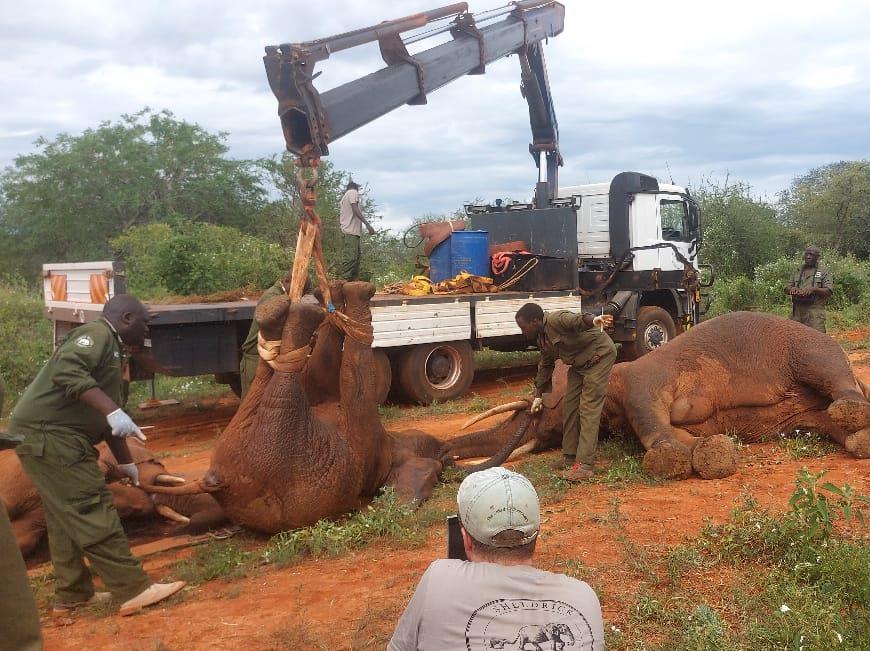
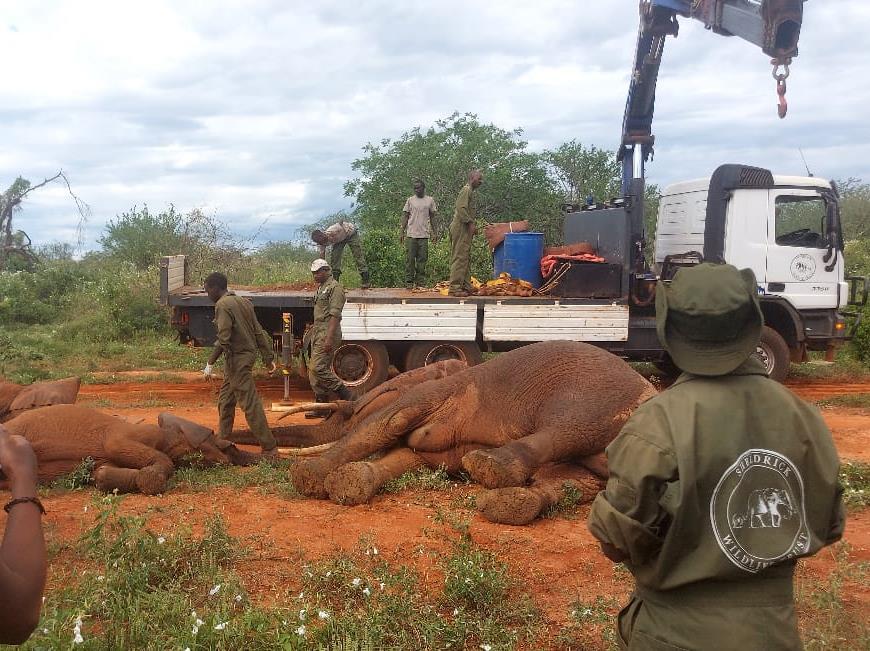
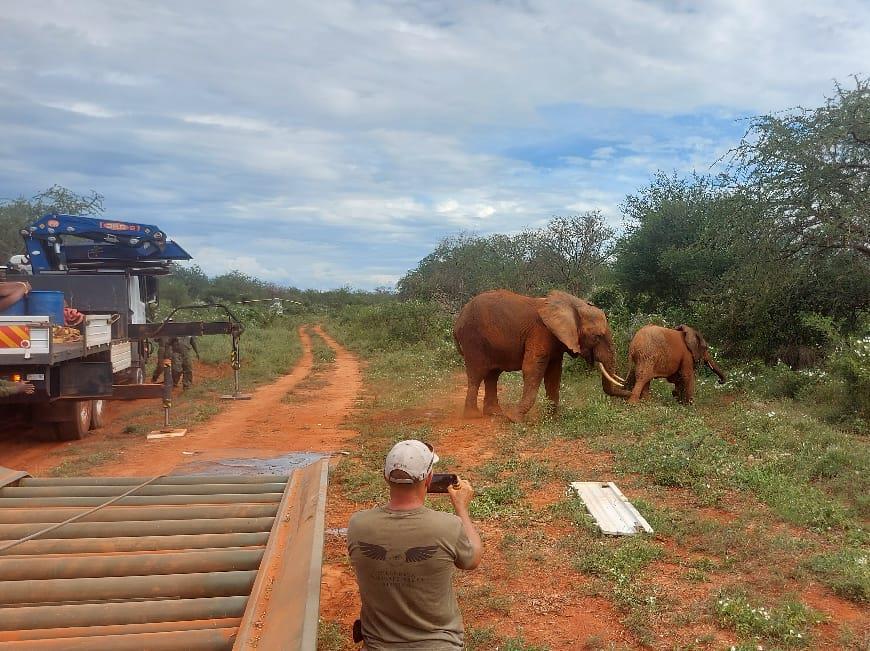
This injured adult elephant bull was seen around Ziwani area by a SWT pilot on routine patrol. The elephant had a swelling on the lateral surface of his left thigh and wounds on the left and right flank.
Immobilisation, examination and treatment
The elephant bull was successfully darted from a helicopter and anaesthetized with 22mg Etorphine hydrochloride. Induction time was 7 minutes.
Examination revealed a swelling on the lateral surface of the left thigh and two other septic wounds on the left and right flank area. All the wounds were cleaned with water and all devitalized tissues, pus, and debris removed. The wounds were thereafter flushed with Hydrogen peroxide, rinsed with water and infused with tincture of Iodine. Antibiotic cream was applied on the wounds followed by topical application of antibiotic spray. Amoxicillin antibiotics and anti-inflammatories were also administered parenterally before anaesthesia was reversed with 250mg Naltrexone hydrochloride given intravenously via a prominent ear vein.
Prognosis
The elephant has a good prognosis.

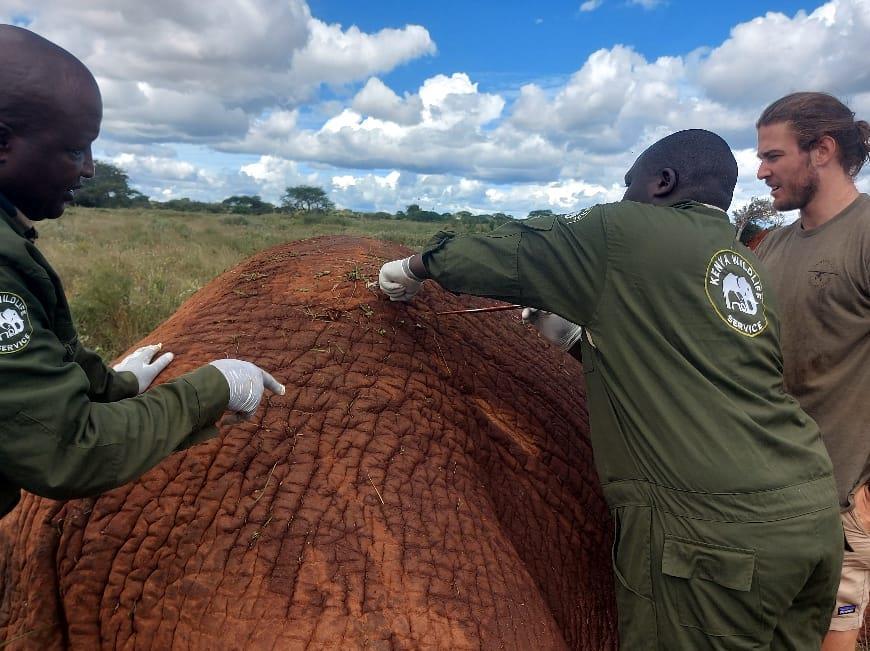
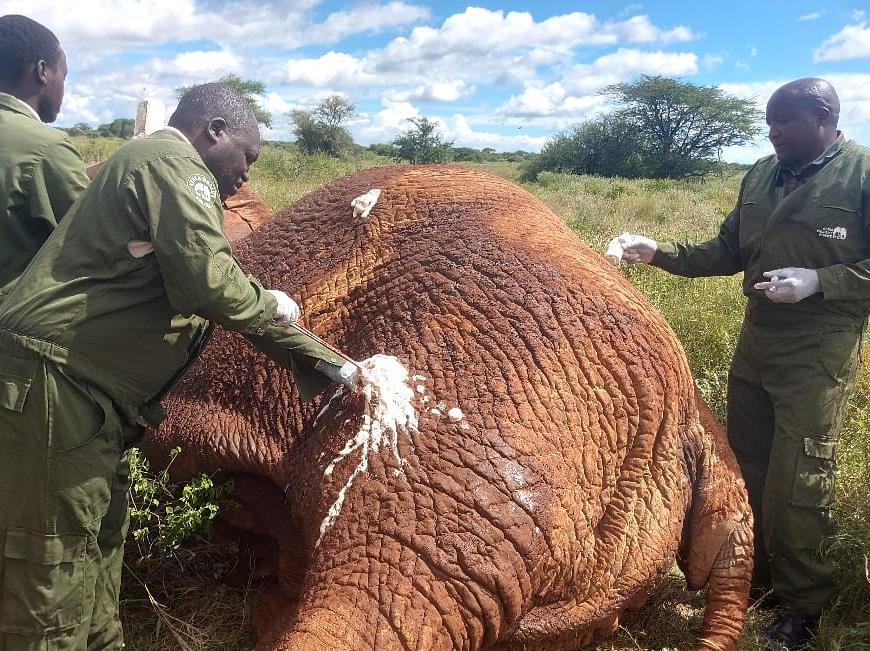

An injured adult elephant bull with a swelling on the left shoulder was seen around Ithumba by a SWT/KWS De-snaring Unit. The bull had been treated for an arrow wound at an earlier date. The Tsavo Mobile Veterinary Unit was airlifted to the Kasala Gate area to attend to the elephant’s injuries.
The bull was darted from a helicopter and successfully immobilized with 18 mg Etorphine hydrochloride. Full anaesthesia was achieved after 8 minutes.
Examination of the left shoulder area revealed a firm swelling with a small opening that was oozing pus. The wound was cleaned of debris and the opening extended to evacuate pus and devitalized tissue. There were bone fragments deep into the wound that had formed as a sequela of osteomyelitis on the fragment of scapular bone. These fragments were removed, then the wound was flushed with Hydrogen peroxide, rinsed with water, infused with tincture of Iodine, packed with antibiotic pessaries, and a topical antibiotic spray applied. Amoxicillin antibiotics and NSAID anti-inflammatory medication was also administered parenterally. Anaesthesia was reversed with 200 mg Naltrexone hydrochloride given intravenously via a prominent ear vein. The elephant bull stood and slowly walked away 3 minutes later.
Prognosis
The elephant bull has a good prognosis.


A female elephant calf with a wire snare on her left hindlimb was sighted by a SWT/KWS De-snaring Unit.
Immobilisation, examination and treatment
The calf was darted from a helicopter and immobilized with 3.5mg Etorphine hydrochloride. It took 4 minutes for the drug to take full effect. Examination revealed that the calf was in poor body condition and severely anaemic. The winch wire snare was deeply embedded at the level of the tibio-tarsal joint of the left hindlimb causing a septic wound. The snare was cut loose with wire cutters then the wound was cleaned thoroughly with water and devitalized tissues and maggots removed. The wound was also flushed with Hydrogen peroxide, rinsed with water and infused with tincture of Iodine. Green clay and topical antibiotic spray were thereafter applied on the wound. Amoxicillin antibiotics, Ivermectin parasiticide, metabolic stimulants and anti-inflammatory medication were also administered parenterally. The calf was revived with 70mg Naltrexone. She was alert 2 minutes later but was unable to stand on her own. The team tried to help her to her feet, but she succumbed a few minutes later.
Prognosis
Sadly, the elephant calf died a few minutes after treatment. The post-mortem examination performed thereafter indicated she died from complications associated with the long-standing snare.




The Mara Vet team attended to an adult male elephant in Olkinyei with an arrow wound on the left forelimb. The arrow had fallen off but had caused swelling of the entire forelimb compromising mobility.
Immobilisation, examination and treatment
He was successfully darted on the hind quarters with 16mgs Etorphine from a helicopter. After ten minutes, the elephant stopped moving and kept swaying from side to side. An attempt was done to physically bring down the elephant to lateral recumbency by pushing the elephant to one side. The efforts seemed futile but after a few trials, he went down on sternal recumbency with the help of a landcruiser.
The arrow was absent, but infection had set in. The wound was first thoroughly cleaned with Hydrogen peroxide then water and finally Iodine was applied. Topical antibiotic was infiltrated into the wound and finally it was sprayed with Tetracycline. Systemically it was injected with 3000mgs of Amoxicillin into two muscle sites and 40mgs Dexamethasone into the muscle.
Prognosis
The prognosis is good and monitoring continues.



